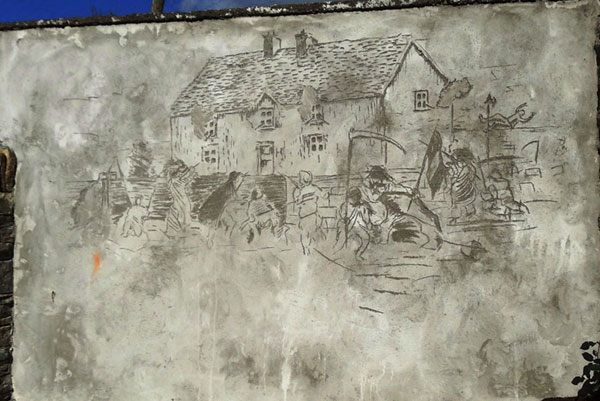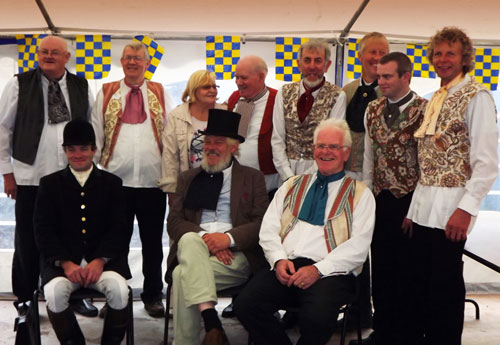The Famine Warhouse 1848
(Artwork by Seamus Lanigan & Tim O'Connell at Ballingarry historic Corner)

An Etching in plaster of the original home of Widow McCormack's family from a pencil drawing published in the Illustrated London News dated August 12th 1848.
Father John Kenyon's involvement in the preparation for war caused serious concerns for his Bishop Dr Kennedy. When in April 1848, he encouraged a crowd of ten thousand people at Templederry to arm themselves; Dr Kennedy immediately suspended him from clerical duties. He was presented with an ultimatum to either give up politics or be expelled from the priesthood. A compromise was arrived at whereby he agreed that he would not involve himself in the rising unless he considered that there was a reasonable chance of success. Unfortunately he did not explain this constraint to his colleagues – a fact that caused much misunderstanding and anger as the Confederates assembled in Ballingarry County Tipperary a few weeks later.
On Thursday 27 July as the Confederates assembled at Ballingarry, William Smith O'Brien dispatched Thomas Francis Meagher, to request Father Kenyon to lead out his men. It was intended that Kenyon's leadership would extend the rising to North Tipperary, and into Limerick where Richard O'Gorman was awaiting orders. Kenyon's response was unexpected. He refused, stating that he was not prepared to become involved in "a bootless struggle." Later he wrote in the parish register: "This evening I have heard of a rebellion in South Tipperary under the leadership of William Smith O'Brien – may God speed it.
Young Ireland Pageant participants, The Commons Sat July 27th 2013

Thomas Francis Meagher, - Seamus Kelly –
William Smith O’Brien, - Liam Noonan
John Blake Dillon, - Bill Martin
L to R:- Back.
Terence Bellew McManus, - Mick Kavanagh
James Stephens, - Paddy Moloney
(Annie Heaphy, wardrobe)
Michael Doheny, - Dan Doheny
James Stephens - John O' Connell
John O' Mahony - Leslie Smyth
David Power Conyngham - Adrian Kelly
Richard O'Gorman - Matty Alexander
Smith O’Brien, James Stephens and Terence Bellow McManus remain in the Commons.
Meagher, O’Donoghue, Leyne and Thomas Devin Reilly – headed for the Comeraghs and stay with John O’Mahony at Hanrahans near Nine-Mile-House on the Friday night 28th, A messenger dispatched to Ballingarry returned with false information. The truth only became clear when they were joined by McManus who had escaped from Ballingarry. August 4th Smith O’Brien was arrested as he was waiting for a train at Thurles Station. Meagher, O’Donoghue, Leyne, Thomas Devin Reilly & John O’Mahony were all arrested near Clonoulty Sunday 13th August.
Michael Doheny went to raise Slievenamon, John Blake Dillon to raise Ballaghadereen. both escaped with James Stephens to France Oct 4th and thence to America.
SMITH O’BRIEN’S LETTER TO THE MINING COMPANY OF IRELAND
The events of the week 24 - 29 July, 1848 have special significance for the people of the Commons. The monument recently erected at the cross-roads in the village tells us that it was here in Sullivans Public House that some of Ireland’s most distinguished patriots met on the evening of Thursday 28th July, 1848 to determine a course of action for the Irish Confederation - We now know that apart from William Smith O’Brien, James Stephens, Terence Bellew McManus and Patrick O’Donohue, the other leaders left the Commons to prepare for a Rising in Autumn.
The encounter at the Warhouse next day terminated all these plans. I include two items concerning 1848 in this piece, one is the little known Smith O'Brien letter to the Mining Company of Ireland which indicates his sympathy with the plight of the miners many of whom had been laid off due to the recession caused by the Famine. This letter was written some time during the early morning of 29th July, and delivered to Mr. Cullen, Manager of the collieries.
It was one of the Acts of Treason with which O’Brien was later charged at Clonmel. The letter demonstrates that O’Brien was not oblivious of the world of commerce and it may well have been the first reference to nationalisation of the Mines. (Ref,William Nolan)
This letter is dated, 29th of July, 1848.
"Mr. William Smith O’Brien presents his compliments to the Directors of the Mining Company, and feeling it incumbent upon him to do all in his power to prevent the inhabitants of the collieries from suffering inconvenience, in consequence of the noble and courageous protection afforded by them to him, takes the liberty of offering the following suggestions:- He recommends that for the present the whole of the proceeds arising weekly from the sale of coal and culm be applied in payment of men employed by contract in raising coal and culm."
"He recommends that a brisk demand be encouraged by lowering the price of coal and culm to the public."
"In case he should find that the Mining Company endeavours to distress the people by witholding wages and other means, Mr. O’Brien will instruct the colliers to occupy and work the mines on their own account; and in case the Irish revolution should succeed, the property of the Mining Company will be confiscated as national property."
"On the contrary, if the Mining Company observes a strict and honourable neutrality, doing their utmost to give support to the population of this district during their present time of difficulty and trial, then their property shall be protected to the utmost extent of Mr. O’Briens power."
THE NINE CONVICTS
During the young Ireland revolution of 1848, nine young Irishmen were captured, tried and convicted of treason against the Queen. The sentence was death. The Presiding Judge read out the names of the condemned men
Charles Gavin Duffy.
Thomas Francis Meagher.
Patrick Donahue.
Tcrence McManus,
Richard O’Gorman,
Morris Leyne,
Michael Ireland,
Thomas Darcy McGee
John Mitchell.
"Have you anything to say before the court passes sentence?"
Thomas Meagher had been chosen to speak for them all "My Lord this is our first offence, but not our last, if you will be easy wtth us this once, we promise on our word as gentlemen to try to do better the next tine, and the next time sure we won't be fools enough to get caught." The indignant judge sentenced them to be hanged by the neck. but passionate protests from all over the world forced Queen Victoria to commute the sentence, the men were transported for
life to the penal colony of the then savage Australia.
In 1871 a Sir Charles Gavin Duffy was elected Prime Minister of the Australian state of Victoria. To her amazement Queen Victoria learned from her Prime Minister Disraeli that this was the same CHARLES GAVIN DUFFY who bad been transported for treason 23 years before. She demanded the records of the other eight convicts and this is what she learned.
THOMAS FRANCIS MEAGHER was Governor of Montana.
PATRICK DONOHOE and TERENCE BELLOW MACMANUS were Brigadier Generals in the US. Army,
RICHARD O'GORMAN was Governor General of Newfoundland.
MORRIS LEYNE was Attorney General of Australia to which office MICHAEL IRELAND succeeded.
THOMAS DARCY MAGEE was President of the Dominion of Canada
JOHN MITCHELL was elected for Tipperary to the British House of Commons, only to be disqualified because he was a convicted felon. (His grandson John Purroy Mitchel (July 19, 1879 - July 6, 1918) was Mayor of New York from 1914 to 1917 at age 34)
This amazing true story of nine men banished from their native land to a penal colony for their political views, and in later years becoming outstanding citizens in America, Australia, and Canada, is now a part of the United States Congressional Record in Washington. D.C.
United Irish Center. Inc
2700 - 45TH AVENUE
SAN FRANCISCO CA 94116
[415) 661 -2700
A Non-Profit Organization
Not Responsible For Lost Articles
Famine Warhouse 1848 - Official Opening 2004

OPENING HOURS
2.30 - 5.30pm
Wednesday, Thursday, Friday, Saturday and Sunday between April and September inclusive
and from 2 - 4pm every Saturday and Sunday from October to March inclusive.
ADM: FREE
At other times it is freely open by appointment, contact the OPW local number 087-9089972 (this number is on the signs at the public road entrance) or from outside Ireland +353 87 9089972.
Free Visitors’ Guide leaflets available in both Irish and English.